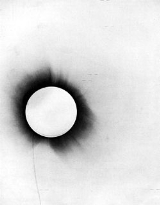
(28 December 1882 – 22 November 1944) was a British astrophysicist of the early 20th century. He was also a philosopher of science
and a popularizer of science. The Eddington limit, the natural limit to the luminosity
of stars, or the radiation generated by accretion onto a compact object, is named in his honour.
He is famous for his work regarding the Theory of Relativity
. Eddington wrote a number of articles which announced and explained Einstein's
theory of general relativity
to the English-speaking world.
We have found a strange footprint on the shores of the unknown. We have devised profound theories, one after another, to account for its origins. At last, we have succeeded in reconstructing the creature that made the footprint. And lo! It is our own.![]()
Physics has in the main contented itself with studying the abridged edition of the book of nature.![]()
I think that science would never have achieved much progress if it had always imagined unknown obstacles hidden round every corner. At least we may peer gingerly round the corner, and perhaps we shall find there is nothing very formidable after all.![]()
There once was a brainy baboon,Who always breathed down a bassoon,For he said, "It appearsThat in billions of yearsI shall certainly hit on a tune".![]()
It is also a good rule not to put overmuch confidence in the observational results that are put forward until they are confirmed by theory.![]()
We used to think that if we knew one, we knew two, because one and one are two. We are finding that we must learn a great deal more about 'and'.![]()

